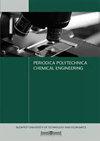Analysis and Comparison of Gas Chromatographic Columns with Polyethylene Glycol Stationary Phase
IF 1.8
4区 工程技术
Q3 ENGINEERING, CHEMICAL
引用次数: 0
Abstract
Gas chromatographic capillary columns with polyethylene glycol (PEG) stationary phase are very frequently used. Their polar character makes them able to analyze many molecules. Alcohols, ketones, aldehydes, and esters can be measured easily, but also molecules with acidic or alkaline characteristics can be separated. For these components, there are also acidic and alkaline modified PEG phases.When we want to buy a new column, we can choose from many manufacturers. Everyone tells us their column is the best, but we don’t know the real differences between these columns. It is because every manufacturer has its testing method under different circumstances and uses different test molecules. Also, they give us only a couple of information about the column, but that is not helpful in every case.We used an 8-component test mixture to compare the WAX columns of 6 manufacturers. The chromatogram lets us see the retention, resolution, and peak shape. We completed these parameters with the columns' efficiency and the sorption enthalpies and entropies of the analyzed compound. With these similar conditions, we can now compare the columns from different manufacturers and show more information about the columns to help the customer choose the best for the analysis.气相色谱柱与聚乙二醇固定相的分析与比较
气相色谱毛细管柱与聚乙二醇(PEG)固定相是非常常用的。它们的极性特性使它们能够分析许多分子。醇类、酮类、醛类和酯类可以很容易地测量,但也可以分离具有酸性或碱性特征的分子。对于这些组分,还有酸性和碱性改性的PEG相。当我们想购买新的立柱时,我们可以从许多厂家中进行选择。每个人都告诉我们他们的专栏是最好的,但我们不知道这些专栏之间的真正区别。因为每个厂家在不同的情况下都有自己的测试方法,使用不同的测试分子。同样,题目只给了我们关于列的一些信息,但这并不是在所有情况下都有用。我们使用一个8组分的测试混合物来比较6个厂家的WAX柱。色谱图让我们看到保留度、分辨率和峰形。我们用色谱柱的效率和被分析化合物的吸附焓和熵来完成这些参数。有了这些相似的条件,我们现在可以比较来自不同制造商的列,并显示有关列的更多信息,以帮助客户选择最适合分析的列。
本文章由计算机程序翻译,如有差异,请以英文原文为准。
求助全文
约1分钟内获得全文
求助全文
来源期刊

Periodica Polytechnica Chemical Engineering
ENGINEERING, CHEMICAL-
CiteScore
3.10
自引率
7.70%
发文量
44
审稿时长
>12 weeks
期刊介绍:
The main scope of the journal is to publish original research articles in the wide field of chemical engineering including environmental and bioengineering.
 求助内容:
求助内容: 应助结果提醒方式:
应助结果提醒方式:


